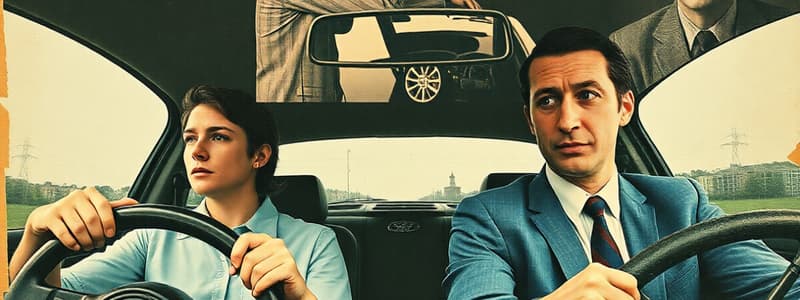Podcast
Questions and Answers
What percentage of drivers believe their parking skills are better than the average driver?
What percentage of drivers believe their parking skills are better than the average driver?
- 77.4%
- 34.2%
- 65.8% (correct)
- 22.6%
What is characterized as having false beliefs with beneficial consequences?
What is characterized as having false beliefs with beneficial consequences?
- Self-Handicapping
- Negative Attribution
- Cognitive Dissonance
- Positive Illusions (correct)
In Attribution Theory, which type of attributions is based on external factors?
In Attribution Theory, which type of attributions is based on external factors?
- Causal Attributions
- Self-Attributions
- Situational Attributions (correct)
- Dispositional Attributions
What type of thinking is System 1 according to Daniel Kahneman?
What type of thinking is System 1 according to Daniel Kahneman?
What percentage of respondents rated their leadership skills as average?
What percentage of respondents rated their leadership skills as average?
What does Attribution Theory primarily address?
What does Attribution Theory primarily address?
Which of the following correlates with psychological well-being according to the content?
Which of the following correlates with psychological well-being according to the content?
What percentage of respondents consider themselves safer than the average driver?
What percentage of respondents consider themselves safer than the average driver?
What does fast thinking typically refer to in the context of Daniel Kahneman's work?
What does fast thinking typically refer to in the context of Daniel Kahneman's work?
Which of these percentages indicate that a respondent rated their skills below average?
Which of these percentages indicate that a respondent rated their skills below average?
Which of the following statements best represents the idea that our behavior is influenced by social contexts?
Which of the following statements best represents the idea that our behavior is influenced by social contexts?
What is a primary concern of social psychologists regarding individual identity?
What is a primary concern of social psychologists regarding individual identity?
What does 'self-serving bias' typically involve?
What does 'self-serving bias' typically involve?
How does the concept of 'impression management' relate to the self?
How does the concept of 'impression management' relate to the self?
What philosophical perspective is highlighted by Jean Paul Sartre regarding self and society?
What philosophical perspective is highlighted by Jean Paul Sartre regarding self and society?
Which question reflects a common inquiry into the nature of the self?
Which question reflects a common inquiry into the nature of the self?
What role do cognitive biases play in self-evaluation?
What role do cognitive biases play in self-evaluation?
What do social psychologists think contributes to group conflict?
What do social psychologists think contributes to group conflict?
In what way can social media complicate the perception of the self?
In what way can social media complicate the perception of the self?
Which statement best illustrates a common belief regarding success and failure?
Which statement best illustrates a common belief regarding success and failure?
What characterizes System 2 thinking?
What characterizes System 2 thinking?
The fundamental attribution error primarily involves the tendency to attribute behavior to which factors?
The fundamental attribution error primarily involves the tendency to attribute behavior to which factors?
What observation can be made about the actor-observer bias in social situations?
What observation can be made about the actor-observer bias in social situations?
In the Asch experiment, what percentage of participants conformed at least once?
In the Asch experiment, what percentage of participants conformed at least once?
What happens to the error rate in the Asch experiment without social pressure?
What happens to the error rate in the Asch experiment without social pressure?
What concept refers to our inclination to rationalize our own behaviors differently than those of others?
What concept refers to our inclination to rationalize our own behaviors differently than those of others?
What is a common effect on decision-making due to System 1 thinking?
What is a common effect on decision-making due to System 1 thinking?
Which of the following statements about situational influences is true?
Which of the following statements about situational influences is true?
Leon Festinger's quote suggests what about human behavior?
Leon Festinger's quote suggests what about human behavior?
In terms of conformity, what is the significance of the Asch Experiment?
In terms of conformity, what is the significance of the Asch Experiment?
Flashcards
Positive Illusions
Positive Illusions
The tendency to hold overly positive and unrealistic beliefs about ourselves, our abilities, and our future.
Illusions of Control
Illusions of Control
The perception that we have more control over events than we actually do.
Unrealistic Optimism
Unrealistic Optimism
A tendency to be overly optimistic about the future, even in the face of potential risks.
Attribution
Attribution
Signup and view all the flashcards
Situational Attributions
Situational Attributions
Signup and view all the flashcards
Dispositional Attributions
Dispositional Attributions
Signup and view all the flashcards
System 1 Thinking
System 1 Thinking
Signup and view all the flashcards
System 2 Thinking
System 2 Thinking
Signup and view all the flashcards
Leadership Skill Self-Perception
Leadership Skill Self-Perception
Signup and view all the flashcards
Attribution Theory
Attribution Theory
Signup and view all the flashcards
Social Psychology
Social Psychology
Signup and view all the flashcards
Self-Serving Bias
Self-Serving Bias
Signup and view all the flashcards
Impression Management
Impression Management
Signup and view all the flashcards
Self & Society
Self & Society
Signup and view all the flashcards
The Self
The Self
Signup and view all the flashcards
Defense of Self
Defense of Self
Signup and view all the flashcards
Social Cognition
Social Cognition
Signup and view all the flashcards
Questions Social Psychologists Ask
Questions Social Psychologists Ask
Signup and view all the flashcards
Fundamental Attribution Error
Fundamental Attribution Error
Signup and view all the flashcards
Actor-Observer Bias
Actor-Observer Bias
Signup and view all the flashcards
Conformity
Conformity
Signup and view all the flashcards
Asch Experiment
Asch Experiment
Signup and view all the flashcards
Group Dynamics
Group Dynamics
Signup and view all the flashcards
Pressure to Conform
Pressure to Conform
Signup and view all the flashcards
Rationalizing
Rationalizing
Signup and view all the flashcards
Study Notes
Social Psychology 100
- All psychology is social psychology.
- Human behavior is significantly influenced by social factors and interactions with others.
- Social psychologists explore questions like:
- Individual identity and its connection to others
- How others influence thought processes
- Explanations for behaviors, attractions, and repulsions between people
- Influence of groups on behavior
- Factors causing conflict and harmony within groups
The Self: Who Are We?
- The self exists in relation to societal interactions.
- Individuals constantly assess themselves in comparison to others.
- Questions about self-perception include:
- Self-image
- Beliefs
- Strengths and weaknesses
- Expectations of others
- Personal desires and aspirations
- Belonging to groups and social comparisons
- The concept of self is a bridge connecting internal thoughts with external social experiences
Self & Impression Management
- Individuals actively participate in shaping how others perceive them.
- This is often unconscious.
- People manage their impressions to appear as they want to be perceived by others.
- This behavior is driven, in part, to present a genuine or desired self-image.
The Self & Social Media
- How one presents oneself online can differ from real-life self-image.
The Defense of Self
- The need to maintain a positive self-image drives people's behavior.
- People defend against negative self-perceptions through various cognitive mechanisms.
Social Thinking (Social Cognition)
- Social cognition refers to how people think about and interpret social interactions.
- The self-serving bias is a prominent cognitive bias in social cognition.
- Individuals often take credit for successes and attribute failures to external factors.
- People often overestimate their positive attributes relative to others.
Positive Illusions
- Positive illusions are false but beneficial beliefs that people have about themselves.
- Positive self-views
- Illusions of control
- Unrealistic optimism
- Studies reveal that these positive illusions are correlated with psychological well-being.
Attribution Theory
- Attribution theory explains how people interpret the causes of behavior.
- Situational attribution: Attributing actions to outside/environmental factors
- Dispositional attribution: Attributing actions to internal factors (personality, traits)
A 'Dual System' of Thinking
- System 1 (Fast):
- Default mode of thinking
- Automatic and effortless
- Used for quick decisions and judgments
- System 2 (Slow):
- Effortful and deliberate
- Requires concentration and demands attention
The Fundamental Attribution Error
- This error is the tendency to overemphasize internal factors and underestimate situational influences when explaining other people's behavior.
- Often, observers miss or neglect context.
- Evaluating situational factors demands 'slow thinking.'
The Actor-Observer Bias
- Actors (those performing actions) tend to attribute their actions to situational factors.
- Observers tend to attribute the same actions, performed by others, to dispositional factors (character or personality).
Group Dynamics
- This examines how behavior is influenced within a group setting.
The Pressure to Conform
- Human behavior is frequently affected by the opinions and actions of others.
- Conformity is pervasive when individuals seek acceptance by their peers or groups.
The Asch Experiment
- Found that substantial conformity exists in unanimous groups.
- Individuals change their opinions or actions to 'fit in' with the majority.
- Social pressure is a strong determinant in conformity.
Conditions of Conformity
- Task difficulty and presence of an ally decrease conformity.
- Public declarations increase conformity; private ones reduce it
Conformity & Consensus
- Group size plays a crucial role in influencing conformity levels.
- At least three people providing the wrong answer typically increases the level of conformity substantially.
- Conformity rates (approximately 37%) reduce the need for further participants to be added.
Types of Conformity
- Informational conformity: conforming because you believe others have accurate information.
- Normative conformity: conforming because of a perceived desire for acceptance and avoidance of disapproval.
Groupthink
- Groupthink is a deterioration of critical thinking in a group setting, often driven by peer pressure and desire for harmony. Characteristics of groupthink:
- Collective rationalization
- Pressure to conform
- Illusion of invulnerability
- Illusion of moral correctness
Bystander Effect
- This effect is a social psychological phenomenon where the presence of others hinders helping behavior.
- Diffusion of responsibility: When more people present, the individual's personal sense of responsibility to act decreases.
- Larger group sizes lessen the likelihood of individual intervention.
The 5-Stage Model of Helping
- Individuals might fail to assist in emergency situations due to factors in each of five stages:
- Noticing the Event
- Interpreting the Event as an Emergency
- Assuming Responsibility
- Knowing How to Help
- Implementing the Decision
- Failure at any stage can prevent action.
Obedience to Authority
- The Milgram experiment demonstrated the impact of authority on obedience.
- The majority (65%) of participants obeyed commands even in situations with potentially negative consequences.
- Situational factors, including experimenter's perceived legitimacy and the victim's proximity, significantly influence the level of obedience.
The Stanford Prison Experiment
- The Stanford Prison Experiment highlighted the power of roles, social influence, and situational factors in shaping behavior.
- The results suggest that assigned roles (prison guard vs. prisoner) can significantly change individuals' behavior.
The Lucifer Effect
- Individuals can exhibit harmful or negative behaviors without malice when under severe pressure from situational factors; 'good' people committing 'bad' acts
Zimbardo's Legacy
- The Stanford Prison Experiment highlighted the influences of situational conditions on human behavior.
- Studies like Milgram's experiment and Zimbardo's prison experiment showed that circumstances can lead people to act unexpectedly.
Cognitive Pillars of Conflict
- Stereotypes: Generalized beliefs about groups applied to all members of that group.
- In-group Bias: Favoritism toward and loyalty toward members of one's own group.
The Availability Heuristic
- This cognitive bias refers to relying on readily available information, often vivid examples, rather than accurate statistics.
- Vivid or emotionally charged examples can influence perceptions and attitudes more strongly than statistical information
The 'Just-World' Fallacy
- This bias results from a tendency to assign blame to victims.
- Negative events or circumstances occurring to an out-group are often attributed to the out-group's inherent characteristics or shortcomings.
Prejudice & Discrimination
- Prejudice: unjustified negative attitudes (beliefs and feelings) toward a group and its members
- Discrimination: unjustified negative behaviors toward a group and its members.
Racial Prejudice
- Research has shown a surprising gap between self-reported attitudes and actual behaviors.
Implicit Prejudice
- Implicit prejudice: often unconscious automatic bias about members of a group.
- Research methods: Implicit Association Test (IAT) can measure these biases.
The Mere Exposure Effect
- Repeated exposure to a stimulus can gradually increase liking toward that stimulus.
Studying That Suits You
Use AI to generate personalized quizzes and flashcards to suit your learning preferences.
Related Documents
Description
Explore the fascinating insights into human perception with this quiz on drivers' self-assessment of skills. From Attribution Theory to Daniel Kahneman's concepts of thinking, uncover the psychological factors influencing our beliefs about performance in driving. Test your understanding of how we evaluate ourselves compared to others and the implications of these beliefs.




